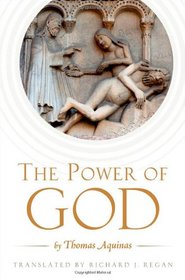Novel Format for Disputed Questions: Richard Regan's Translation of Thomas's "De potentia dei"
/ As somewhat of a purist when it comes to the form of the Disputed Questions, I always warn students away from editions of Thomas’s works that condense or eliminate the objections and replies from the original Articles in the Summa Theologiae or in a set of Disputed Questions. I consider the very setting-forth of the contrary arguments on either side of a given issue to be the essential, and indeed distinctive, starting-point to the medieval scholastic method.
As somewhat of a purist when it comes to the form of the Disputed Questions, I always warn students away from editions of Thomas’s works that condense or eliminate the objections and replies from the original Articles in the Summa Theologiae or in a set of Disputed Questions. I consider the very setting-forth of the contrary arguments on either side of a given issue to be the essential, and indeed distinctive, starting-point to the medieval scholastic method.
Yet I recognize the limits of time and energy of my students. I counsel them that if they are in a pinch for time and are unfamiliar with the topic of an Article, that they should first start by reading Thomas’s response. Once they have an idea about what Thomas is arguing, then they should go back to each objection and see how Thomas applies the distinctions and clarification from the response in the corresponding reply to that objection. I also note that sometimes Thomas will make his most significant point in a reply to an objection, so they should pay special attention to the longer replies.
I am thus somewhat intrigued by Richard Regan’s new edition of Thomas’s De potentia dei (The Power of God by Thomas Aquinas. Oxford, 2012). In this edition, Regan has condensed each article, noting that the text would be double in size if he were to include each and every objection and reply. Instead, Regan has included only the more significant objections and replies to those objections.
Regan has also reformatted the sequence of elements, placing Thomas’s response first, followed by the selected objections, each coupled immediately with the corresponding reply.
This is intended to suit the purpose of this edition, which is aimed at students and more general readers looking to “comprehend the basic questions and answers” at play.
Since this format follows exactly the procedure I counsel for my own students, I should be very pleased, especially since the text is thereby affordable. I have yet to teach from it, so the jury is out as to how my students will fare with it.
Yet there is a part of me that longs for the opportunity that would come with the ideal situation I envision for my students, who would truly immerse themselves in the issue at stake by taking the arguments on all sides of a question seriously, and thus appreciating why it is a genuine question to begin with, and further appreciating Thomas’s own resolution.
I guess I will have to teach from it before I render a decision on this novel format.

